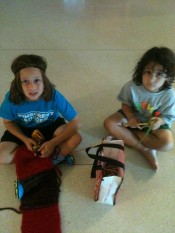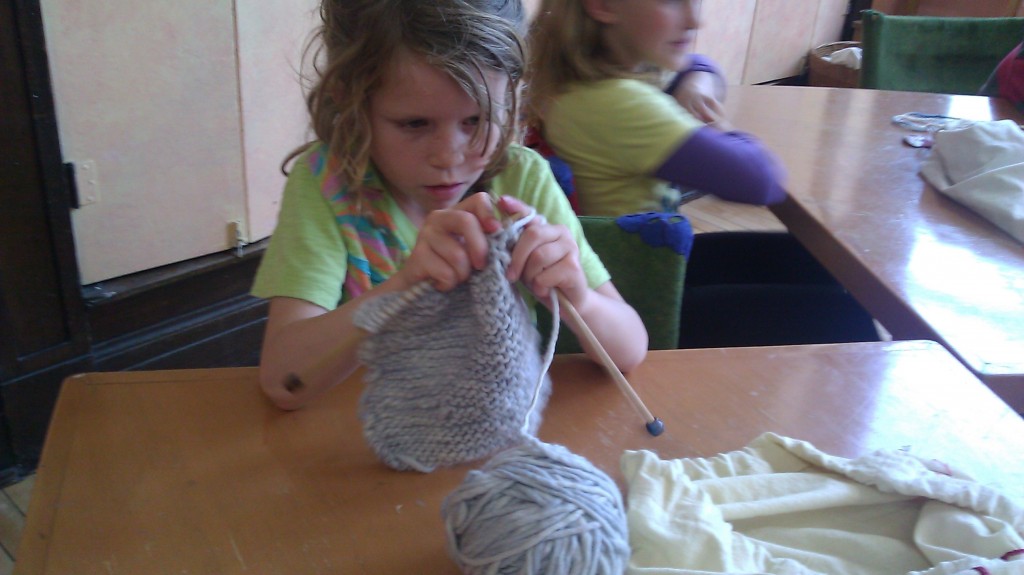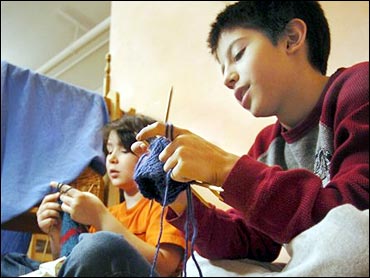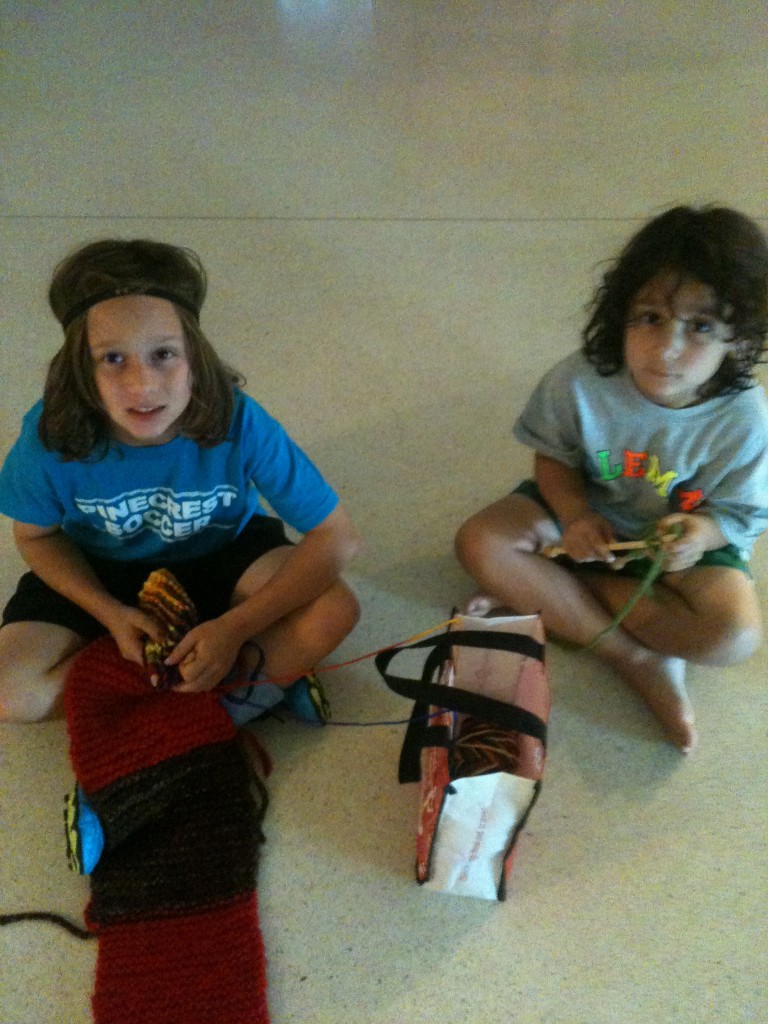Waldorf News
Knitting Is More Important Than Homework

By MARA MENACHEM
Two years ago on the front page of the New York Times Sunday Business section, an article ran entitled, “A Silicon Valley School That Doesn’t Compute” about the Waldorf School in Silicon Valley. I had already made the decision to enter my oldest son in a Waldorf school before the article came out, but I pathetically admit that this piece in the New York Times validated my intuition regarding a Waldorf education.
Years ago when I was looking at preschools, I checked out a Waldorf School. At the time, despite my hippie pre-disposition, the environment seemed too “out there.” However, I trusted my intuition enough to send my kids to another somewhat alternative, small, liberal pre-school focusing on socialization, not academics. The kids were happy, as were we. My kids were little Huck Finns and I was comfortable as their pied piper as they explored their world, not competed in it. But when it came time for elementary school, going “alternative” seemed a little too “alternative.”
Traditional private school didn’t do it for me as a kid. I went to private school and felt stifled. I wanted something different for my kids. In my mind, I saw my kids being raised with limitless imagination and access to never-ending creativity, even after pre-school. My perspective always seemed to be different from the majority. My intellectual buddies (although many sans kids) served as the great validators of my gut feelings regarding how I handled certain situations. Over time, I also learned to rely on my own intuition. I felt that traditional private school was too regimented, so I naturally looked elsewhere for the right environment for my kids.
When it came to sending my kids to elementary school, it was determined that we would send them to the “best” (based on rating) public school in our area. We even moved to the “right” neighborhood to guarantee entrance. I must admit that we were relieved to not have to spend money on private school. So our oldest entered public school at the age of 5.
It took us time to adjust, especially me. I was expected to be very involved and was balancing working “part-time” raising money for an important charity while dealing with adjusting to homework and daily public school paper work. I remember thinking, Is this school or a government bureaucracy?
 Two veteran moms, spotted this rookie and took me under their wings. They warned me about all the supplies we would need and special projects to prepare for. Because if I wasn’t, at this high-achieving school, my kid would be the only one without a pumpkin to carve for Halloween… you get my point.
Two veteran moms, spotted this rookie and took me under their wings. They warned me about all the supplies we would need and special projects to prepare for. Because if I wasn’t, at this high-achieving school, my kid would be the only one without a pumpkin to carve for Halloween… you get my point.
My son’s teacher (who happens to be incredible and famous in the kindergarten world) charmed by my silliness, also took a special interest in reminding me of things via funny text messages. In time, we all adjusted. She also gave me interesting tasks to help in the class, like sharpening pencils or refilling glue. She was aware of my skill set.
I also wasn’t particularly sold on some of the curriculum. On several occasions, and by several I mean dozens, I couldn’t figure out the kindergarten homework instructions. I decided to do the mature thing and blame my son’s laziness and lack of focus for incomplete homework assignments. In no way was I admitting to myself or my son’s kindergarten teacher that I could not comprehend homework created for 5-year-old children. Fortunately, I overheard other parents admitting the same comprehension issue, and felt a sense of relief and quickly canceled my appointment to have a full evaluation with a neuropsychologist.
The more I saw, the more inappropriate the curriculum seemed. For instance, they showed a semi-violent video about Martin Luther King Jr. and the Civil Rights Movement to a bunch of 5- and 6-year-olds (all I know is my son kept talking about a bomb being thrown in his direction). This was a school system-wide tool to teach kids Black History.
I also wanted to teach my kids about well-respected Black leaders. But discussing intolerance and violence with kids who are still so pure and full of love is opening an unnecessary can of worms and frankly, in my opinion, completely inappropriate at such a young age. Take the kids to an African-American church, feed them delicious Soul Food, visit a historically African-American neighborhood, that’s how you teach little kids about other cultures.
To my utter dismay, my son was so confused he thought Black people were the ones who didn’t share their water fountains with White people. So I, who worked at a charity in an African-American community, had a kid who believed the Black man oppressed the White man. That was a fun conversation to have!
You know when people say listen to your gut? One afternoon in first grade, my gut finally talked and I listened. And my gut was yelling at me to help my child be a kid.
I picked up Neal from school and he approached the car with this face of an old man on a mission. I smiled and hugged him (it was first grade) and said “Hey Neal, I brought your skate board, let’s go to the park, get some ice cream and run around!” Neal replied solemnly “No mommy, I have to go home and do my homework and study for my spelling quiz.” I thought to myself, This kid is 7, he should just be coming out of the eating glue faze and moving onto the making farting noises with body parts and perfecting burping the alphabet! I was mad. I tried again, “Ok Neal, how about I take you to get a chocolate-covered donut with sprinkles!” Again, sternly, “No mommy, I have to go home and do my homework!!”
OK, I know most parents would be thrilled with this high-achieving, focused kid. Me, not so much. I want my kids to be responsible and hard-working, but not at 7. At 7, kids should have absolutely no pressure, learning should be organic and socialization the main priority. My kid was under pressure and no offer of high-fructose-corn-syrup-laden food would tear him away from his homework.
That afternoon, I made the decision that my kids would have a completely different type of education. Now, I will say our kids public school had wonderful loving teachers, administrators and staff who work extremely hard and care deeply about the children. But public schools have to follow the guidelines mandated by our state and local government, no matter how ridiculous or impossible.
I realize that we are lucky to be in a position to have the option to pay for private school, as most people in this country do not. I will say that there are thousands of charter schools (some that are Waldorf-inspired) that are not only public, but small, nurturing and alternative in their thinking. Unfortunately, at that time, we would have had to move in order to take advantage of the charter schools.
 So, I began looking at the many private schools in Miami. But they were really not that different than the public school we were leaving. I mean, they were nice environments, warm teachers, small classrooms, but they were traditional in their thoughts about learning.
So, I began looking at the many private schools in Miami. But they were really not that different than the public school we were leaving. I mean, they were nice environments, warm teachers, small classrooms, but they were traditional in their thoughts about learning.
Technology also played a huge role in how they taught. I kept hearing all about “smart boards” and my intuition was like, “Do I really want my kids staring at a huge computer screen all day?” That’s not exciting to me at all.
I really wanted my kids to be in a creative environment. To me, the arts are just as important as reading and mathematics. I never particularly excelled in “typical” academics, but only later learned in college that I was actually highly creative and very good at critical thinking. I wanted my kids to realize their gifts, way before college.
Then I remembered Waldorf. The one I visited years ago did not resonate with me. But there were others. I called a fairly new Waldorf school in Miami and made an appointment to tour the school. My husband trusts my intuition as a parent and basically was cool with whatever I thought was the best environment for our kids.
I toured the school and fell in love. So much so that, ironically, rather than celebrating a major find, in anger I called my mother to ask her why she didn’t send me to a Waldorf School. “Mom,” I spoke in my best moody tone, “why didn’t you find a school like this for me? Think of all the time I wasted learning how to forge your signature to get out of Physical Education!” I guess seeing this place made me realize how amazing school could have been.
My brilliant, Ivy League-educated friend Lauren sent her children to Waldorf and because I am not good with details, she convinced me that the academics were totally fine. Listening to her well-articulated explanation of the school’s overall curriculum, I realized my kids would become more than just awesome knitters.
Neal, and we, entered the Waldorf world. Without boring you with details about the Waldorf philosophy and its extension to our home life, I will tell you we limited all media to only minimal on the weekends, junk food is not permitted at school and they ask that kids don’t participate in competitive sports or overload on activities until they are older.
I noticed on Waldorf play dates that Neal was doing the same stuff other kids at Waldorf do — climb trees, build forts, look for insects and snakes, jump and run through puddles and play in the rain. And without technology present, they just did these things more. Even more amazing, they can do this stuff after school. Waldorf does not give homework until fourth grade. What a relief.
Waldorf teaches emotional/social development, which is insanely important. My youngest son Liam switched to Waldorf this year. He is different from Neal. Like me, he has a stop to smell the roses approach to life. Because it’s not a race at Waldorf, it’s more important to do things correctly no matter how long it takes. Liam is loving it.
All kids learn to knit at Waldorf. It is taught even before the alphabet. It perfects fine motor skills, has been said to improve memory, works both sides of the brain, and prepares children to be better readers when they are ready for that step. I find it so cool to watch my boys knit and crochet, they love it and it gives them a sense of accomplishment. Currently, I am using their skills to make scarves and sell them to cover their tuition costs (OK not really, but not a bad idea).
I am very aware that Waldorf is not free of controversy and it’s not for everyone. I know there is an idea about Waldorf parents being cultish hippies or extremists who make their kids grow their own food. That’s not true at all. Some follow all the “rules” and some, like me, do it in our own way that feels right for our family. I don’t believe in extremes, but I do believe in having a childhood that’s free of stress and pressure and filled with imagination and wonder.
Many people question how Waldorf’s belief in gnomes and other folklore may cause an unrealistic view of the world in early childhood. But the world Waldorf creates for children, is one that fosters total imagination — a world in which all children should live. I never really believed in exposing young children to the “real world” as other parents would mention. It seemed to them that not exposing children to this “real world” would somehow create naive, incapable and the worst of all “non-competitive” humans. These ideas to me were foreign. I wanted my children to be naive and wasn’t interested in fostering a competitive nature. I didn’t realize that my ideologies regarding child rearing was quite in line with the Waldorf philosophy.
My boys would have been fine if they stayed in public school, but Waldorf is a priceless gift and I am glad I unwrapped it. The Waldorf tradition teaches kids about humanity… how to just be good humans. For my son Liam’s birthday and his last day of school (we are moving to California), his teacher, Ms. Pattie, wrote him a beautiful poem. She lit the candle on his cake (freshly baked by my mom) and instructed Liam not to make a wish yet. Ms. Pattie looked at the class and asked each child to tell Liam what their wish is for him. Without hesitation (these are 7- and 8-year-olds), one by one, these well-rounded, wholesome, age-appropriate children looked Liam straight in the eyes and shared their sweet wishes. “I wish you love your new school and make friends in San Francisco,” “I wish you the best birthday and hope you love San Francisco, I will miss you so much.”
A moment like this one only makes me feel that I have made the absolute, unequivocal right choice for my children. No, they are not learning in a “traditional” way, but they are growing into empathetic, incredibly well-rounded, good and, most importantly, happy humans. And that’s what I want for my boys. Period. The end.
“Old fashioned play builds serious skills”
And many more articles and news about Waldorf at waldorftoday.com

Mara’s article originally appeared in the Huffington Post. To read the article at source, click here.
 Summer Programs - Culminating Class Trips
Summer Programs - Culminating Class Trips Storytelling Skills for Teachers
Storytelling Skills for Teachers Transforming Voices Worldwide
Transforming Voices Worldwide Everything a Teacher Needs
Everything a Teacher Needs Art of Teaching Summer Courses 2025
Art of Teaching Summer Courses 2025 Bay Area Teacher Training
Bay Area Teacher Training Apply Today: New Cohort Starts Nov. 2025
Apply Today: New Cohort Starts Nov. 2025 Grade Level Training in Southern California
Grade Level Training in Southern California Jamie York Books, Resources, Workshops
Jamie York Books, Resources, Workshops Quality Education in the Heartland
Quality Education in the Heartland Bringing Love to Learning for a Lifetime
Bringing Love to Learning for a Lifetime Immersive Academics and Arts
Immersive Academics and Arts Middle School Science With Roberto Trostli
Middle School Science With Roberto Trostli Waldorf-inspired Homeschool Curriculum
Waldorf-inspired Homeschool Curriculum Association for a Healing Education
Association for a Healing Education Train to Teach in Seattle
Train to Teach in Seattle Caring for All Stages of Life
Caring for All Stages of Life ~ Ensoul Your World With Color ~
~ Ensoul Your World With Color ~ The Journey is Everything
The Journey is Everything Flexible preparation for your new grade
Flexible preparation for your new grade Space speaks. Its language is movement.
Space speaks. Its language is movement. Roadmap to Literacy Books & Courses
Roadmap to Literacy Books & Courses Full-Time Teacher Education
Full-Time Teacher Education Waldorf EC Training & Intensives in Canada
Waldorf EC Training & Intensives in Canada RSS Feeds
RSS Feeds